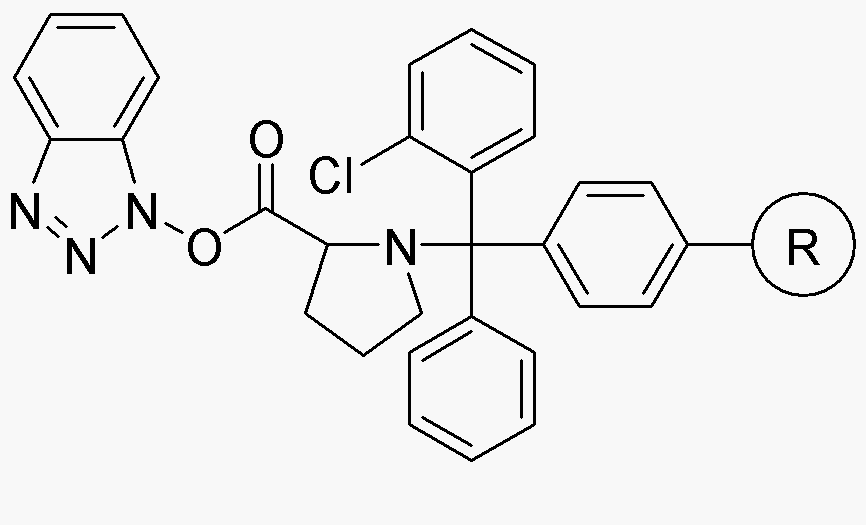N-(2-Chlorotrityl resin)-L-proline benzotriazolyl ester is widely utilized in research focused on
- Peptide Synthesis: This compound serves as a valuable building block in the synthesis of peptides, facilitating the formation of complex structures in pharmaceutical research.
- Drug Development: Its unique properties make it an effective intermediate in the development of novel drugs, particularly in targeting specific biological pathways.
- Bioconjugation: The compound is used for bioconjugation processes, allowing researchers to attach biomolecules to surfaces or other molecules, enhancing the functionality of drugs and diagnostics.
- Material Science: In material science, it can be utilized in the creation of specialized polymers with tailored properties, useful in coatings and adhesives.
- Research Applications: It is also employed in various research applications, including studies on enzyme activity and protein interactions, providing insights into biological mechanisms.
Informations générales
Propriétés
Sécurité et réglementation
Applications
N-(2-Chlorotrityl resin)-L-proline benzotriazolyl ester is widely utilized in research focused on
- Peptide Synthesis: This compound serves as a valuable building block in the synthesis of peptides, facilitating the formation of complex structures in pharmaceutical research.
- Drug Development: Its unique properties make it an effective intermediate in the development of novel drugs, particularly in targeting specific biological pathways.
- Bioconjugation: The compound is used for bioconjugation processes, allowing researchers to attach biomolecules to surfaces or other molecules, enhancing the functionality of drugs and diagnostics.
- Material Science: In material science, it can be utilized in the creation of specialized polymers with tailored properties, useful in coatings and adhesives.
- Research Applications: It is also employed in various research applications, including studies on enzyme activity and protein interactions, providing insights into biological mechanisms.
Documents
Fiches de données de sécurité (FDS)
La FDS fournit des informations de sécurité complètes sur la manipulation, le stockage et l’élimination du produit.
Spécifications du produit (PS)
Le PS fournit une description complète des propriétés du produit, notamment sa composition chimique, son état physique, sa pureté et les exigences de stockage. Il détaille également les plages de qualité acceptables et les applications prévues du produit.
Certificats d'analyse (COA)
Recherchez des certificats d'analyse (COA) en saisissant le numéro de lot du produit. Les numéros de lot et de lot se trouvent sur l'étiquette d'un produit, après les mots « Lot » ou « Lot de fabrication ».
Numéro de catalogue
Numéro de lot/série
Certificats d'origine (COO)
Ce certificat d'exploitation confirme le pays dans lequel le produit a été fabriqué, et détaille également les matériaux et composants utilisés et s'il est issu de sources naturelles, synthétiques ou autres sources spécifiques. Ce certificat peut être requis pour les douanes, le commerce et la conformité réglementaire.
Numéro de catalogue
Numéro de lot/série
Fiches de données de sécurité (FDS)
La FDS fournit des informations de sécurité complètes sur la manipulation, le stockage et l’élimination du produit.
DownloadSpécifications du produit (PS)
Le PS fournit une description complète des propriétés du produit, notamment sa composition chimique, son état physique, sa pureté et les exigences de stockage. Il détaille également les plages de qualité acceptables et les applications prévues du produit.
DownloadCertificats d'analyse (COA)
Recherchez des certificats d'analyse (COA) en saisissant le numéro de lot du produit. Les numéros de lot et de lot se trouvent sur l'étiquette d'un produit, après les mots « Lot » ou « Lot de fabrication ».
Numéro de catalogue
Numéro de lot/série
Certificats d'origine (COO)
Ce certificat d'exploitation confirme le pays dans lequel le produit a été fabriqué, et détaille également les matériaux et composants utilisés et s'il est issu de sources naturelles, synthétiques ou autres sources spécifiques. Ce certificat peut être requis pour les douanes, le commerce et la conformité réglementaire.


